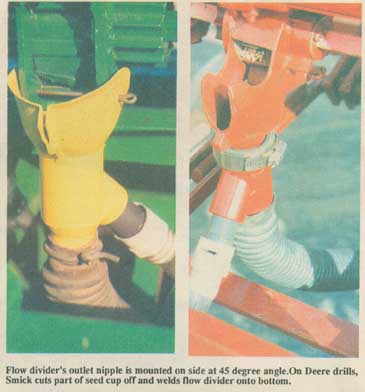
"It lets you seed small grains at two different depths in the row and greatly reduces the odds that you'll have to replant," says Neal Smick, Connell, Wash., who telephoned FARM SHOW recently to tell us about his home-built seed flow divider that mounts on the seed cups of any deep furrow drill.
Smick lives in an area that gets only 7 to 10 in. of rain each year. To overcome the dry conditions, most farmers use a deep furrow drill that places seeds 5 to 6 in. deep. "If it rains before seedlings emerge they have trouble breaking through the crust, and the result is either a complete loss or a thin stand," says Smick. "Dry years can also cause thin stands and bald spots. Deciding whether or not to replant can be agonizing. It always seemed to me that if there were just a few more plants per foot of row, the replanting decision would be much easier."
The flow divider is made from 1 3/4-in. dia. steel tubing and is equipped with a 1 3/16 in. dia. outlet nipple mounted on the side at a 45 degree angle. A 3/4-in. dia. plastic tube runs from the nipple and down the back side of the boot. The extra tube places seeds 1 to 1 1/2 in. deep, above conventionally planted seeds placed 5 to 6 in. deep.
"The flow dividers provide insurance against poor germination by allowing me to plant an extra 20 lbs. or more per acre of seed in shallow dry soil where it will sprout after the first rain. I plant about 40 lbs. per acre deep. I've used my flow dividers for the past 12 years and have never been disappointed with them. They've saved me thousands of dollars in seed and lots of time. The only time I had to reseed was when extremely cold temperatures and high winds in the winter killed the wheat. One year the ground was wet and crusted over and of the 60 lbs. per acre I planted (in late August), only the 20 lbs. per acre planted shallow came up yet I still got a good yield. I can divide the flow between deep and shallow seed at whatever ratio I want by simply using a wrench to turn the fitting on the end of each tube."
To install the flow divider, the drill's seed tube is removed from the bottom of the seed cup and the flow divider is then clamped or pinned onto the cup. The seed tube is then clamped onto the bottom of the flow divider. On Deere drills, Smick cuts part of the seed cup off and welds the flow divider onto the bottom.
